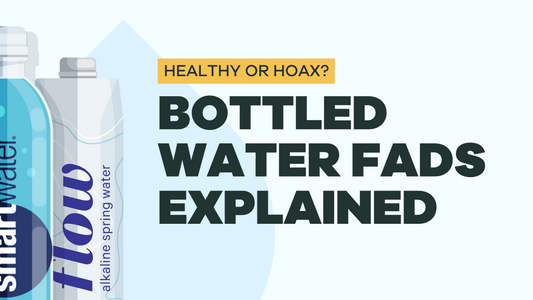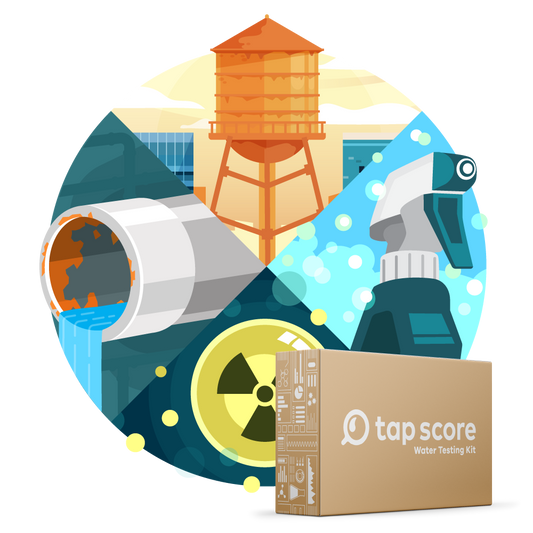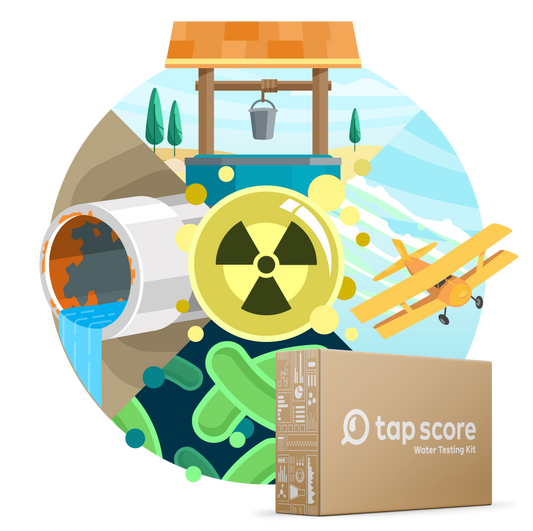
Quick Guide: Trihalomethanes and HAA5/HAA9
While the consensus remains that chlorine (and chloramine) disinfection is indispensable to public health, identifying disinfection byproducts (DBPs) (compounds that are produced when chlorine reacts with other compounds in our water) and their associated risks has become increasingly important to understanding water quality.
In our quick guide, we’ll take a look at the most well-studied of these reactions and their byproducts, explore why they are a cause for concern, and what you can do about them.
Table of Contents:
- What Are Disinfection Byproducts?
- Are Trihalomethanes and Haloacetic Acids Toxic?
- Are Disinfection Byproducts Regulated?
- How Do I Know If My Water Has DBPs?
- Can I Test My Water for DBPs?
- Can I Filter DBPs from My Water?
- What’s the Takeaway?
What Are Disinfection Byproducts?
When chlorine disinfectants interact with naturally occurring organic matter in water and surrounding pipe material, a series of complex chemical reactions occur, leading to the formation of disinfection byproducts, or DBPs.
Overall, water sourced from surface water like rivers or reservoirs—rather than groundwater—tends to be more susceptible to the formation of DBPs because surface waters contain more organic matter. “Organic matter" refers to a wide group of naturally occurring carbon-based compounds found in soil, peat, streams, and lakes as a result of decaying vegetation and animal waste or remains.
Because most DBPs are halogenated compounds and many halogenated compounds are known carcinogens, their presence in most treated drinking water is a concern.[1] The most well known DBPs are:
- Trihalomethanes (THMs or TTHMs)
- Haloacetic acids (HAA5/HAA9)
- Chloride, chlorite, and chlorate
- Bromate (more commonly as a result of ozone disinfection than chlorine)
While over 700 different DBPs have been identified, they are still generally regarded as “emerging contaminants” due to the many that remain unaccounted for and the limited research available.
DBPs tend to be much higher in concentration compared with other emerging contaminants (e.g., up to 1000x higher concentrations) and they can form and change in the water treatment plant, as well as along the distribution line from the water plant to your tap.[2]
What Are Trihalomethanes (THMs)?
Trihalomethanes are a class of DBPs that are well-studied and regulated as a group of four compounds which include:
- Chloroform
- Bromodichloromethane
- Dibromochloromethane
- Bromoform
Excess chlorine, more alkaline (basic) conditions (pH > 7), and water richer in bromide and iodide ions may favor the production of THMs over HAAs.[3]
What Are Haloacetic Acids (HAA5/HAA9)?
Haloacetic acids or HAAs are a group of carboxylic acids that form as disinfection byproducts. In regulation and monitoring, these compounds are grouped in different numbers of haloacetic acids. For example, HAA5 are a group of five disinfection byproducts that are regulated:
- Dichloroacetic acid
- Trichloroacetic acid
- Monochloroacetic acid
- Monobromoacetic acid
- Dibromoacetic acid
In addition to these five regulated HAAs, the Environmental Protection Agency (EPA) has monitored four additional HAAs that are brominated (i.e., include bromine). Though these additional, known as HAA9, were monitored in a previous period of the EPA’s Unregulated Contaminant Monitoring Rule, they remain unregulated in drinking water.
- Bromochloroacetic acid
- Bromodichloroacetic acid
- Dibromochloroacetic acid
- Tribromoacetic acid
The formation of HAA5s over THMs may occur when water contains higher concentrations of organic precursors containing carboxyl and carbonyl groups, more free amino acids and/or is more acidic (ph < 7).[3]
Chlorine, Chloramine and DBPs
Chlorine and chloramine both form DBPs:
- Chlorine in its free form tends to be more reactive with organic matter than chloramine, which means it is both highly effective at killing a wide range of microorganisms quickly and increases the production of the regulated DBPs we covered above. But chlorine has a shorter-lived residual in water than chloramine. This means its effectiveness diminishes over time, so operators often apply chlorine to the drinking water after disinfection as a “residual” disinfectant before the water enters the distribution system. This additional chlorination step can increase the production of DBPs in the distribution line as the chlorine reacts with organic matter inside pipes.
- Chloramine, which is chlorine combined with ammonia, tends to work more slowly and persistently over time. This has suggested it produces fewer disinfection byproducts compared to chlorine. Regulation of DBPs (more on regulation below) even inspired the use of chloramines as an alternative disinfectant because it forms less of regulated DBPs.
It’s important to emphasize that chloraminated water contains different—not necessarily fewer—types of disinfection byproducts. Unregulated byproducts produced through chloramination include iodo-trihalomethanes, iodo-acids, and nitrosodimethylamine (NDMA), the latter of which is a known carcinogen and has toxicities at extremely low concentrations.
Read more in the Quick Guide to Chlorine and Chloramine in Drinking Water
Are Disinfection Byproducts like TTHMs and HAA5s Bad for Your Health?
Studies show that there are some major health risks—including bladder cancer— that can result from long-term exposure to DBPs. Yet waterborne pathogens treated by disinfectants (like Salmonella, Campylobacter, norovirus, etc.) are acute health threats that can be fatal.
As such, treating drinking water presents a trade-off between short-term (e.g., potentially life-threatening infection from pathogens) and long-term health risks (i.e., DBPs). The World Health Organization (WHO) maintains short-term health effects must take precedence, stating that “efficient disinfection must never be compromised.” This is largely because waterborne illness is a leading cause of disease and death for children under 5 and other vulnerable groups.
In industrialized water systems with centralized supply (like those in the United States), researchers and engineers are starting to better understand and regulate the effects of long-term health effects from DBPs. Some countries, like the Netherlands, have gone so far as to ban chlorination entirely in favor of other types of disinfectants (like ozone).
While some DBPs have almost no toxicity, research shows that others have been associated with cancer, reproductive problems, and developmental issues in laboratory animals.[4] This range in potential risk is understood only from a few well-studied DBPs.
For example, in bioassays to assess the toxicity of chlorinated drinking water, DBPs with known chemical identities like THMs account for only 10% of the toxicity. That means that 90% of the toxicity is produced by DBPs that scientists have yet to identify and therefore remain unregulated!
There are a variety of ways that DBPs can enter into the human body, including:
- Ingesting drinking water with DBPs
- Inhaling DBPs—VOCs like THMs may be released into the air when water is at higher temperatures, e.g., showering, doing dishes, etc.
- Absorbing DBPs through the skin while bathing
Health Effects of Trihalomethanes (THMs) in Drinking Water
Research from epidemiological or occupational studies (*), animal models (**), and lab studies (***) indicate a connection between total trihalomethanes (TTHMs) and
- Increased risk of cancer (colon; bladder)*
- Developmental toxicity**
- Immune toxicity**
- Liver and kidney damage**
- Spleen toxicity**
- Genotoxicity***
As with most contaminants in drinking water, exposure concentrations are typically quite low and therefore acute health risks are unlikely. You cannot see, smell, or taste TTHMs. Some TTHMs are better studied than others, but exposure pathways are primarily through drinking water and showering.
Health Effects of Haloacetic Acids (HAA5s) in Drinking Water
There is little research from epidemiological or occupational studies regarding the health effects of HAA5. Animal models indicate a connection between total HAA5 and
- Increased risk of cancer
- Liver and kidney damage
- Harmful effects to fetal growth and development during pregnancy
Similarly to THMs, exposure concentrations of HAA5 in drinking water are low and acute health risks are unlikely.
You can limit or reduce your DBP exposure by way of inhalation by not excessively boiling water, taking shorter showers or with slightly cooler water, or avoiding remaining in heavily chlorinated pools too long.
Note: While being aware of the potential risks of DBPs is helpful, it’s worth noting that public water systems are managed and maintained with regulated DBPs very much in mind.
Are Disinfection Byproducts—like TTHMs and HAA5/HAA9s—Regulated?
The United States EPA has developed a set of Disinfection Byproduct Rules to limit the public’s exposure to DBPs.
The Stage 1 Disinfectants and Disinfection Byproducts Rule (DBPR) works to reduce drinking water exposure to DBPs. The rule applies to public water systems, including those serving fewer than 10,000 people that treat their water with a disinfectant at any point in the process.
The Stage 2 DBPR introduces compliance and monitoring requirements for TTHMs and HAA5s.[5]
Maximum Contaminant Level for Total Trihalomethanes (TTHMs)
If you are a customer of any water system in the United States, the EPA currently regulates TTHMs in your water with a Maximum Contaminant Level (MCL) of 0.08 PPM (parts per million).
Meanwhile, because there are four individual THMs with their own distinct health risks, they are also monitored for their individual concentrations with a Maximum Contaminant Level Goal (MCLG). The MCLG for each THM is as follows:
- Bromodichloromethane: 0 PPM
- Bromoform: 0 PPM
- Dibromochloromethane: 0.06 PPM
- Chloroform: 0.07 PPM
Note: An MCLG is the level of a contaminant in drinking water below which there is no known or expected health risk to humans. MCLGs are not enforced via health regulations and are rather health goals. MCLs are set as close as possible to the MCLG while also considering economic and technical feasibility.
Maximum Contaminant Level for Haloacetic Acids (HAA5s)
If you are a customer of any U.S. water system, then the EPA currently regulates the sum total HAA5s in your water with a Maximum Contaminant Level (MCL) of 0.06 PPM.
How Do I Know If My Water Has Disinfection Byproducts?
Disinfection byproducts cannot be seen, smelled, or tasted. Nevertheless, if you are a customer of a public water system or municipal water utility that chlorinates their drinking water, chances are there are some DBPs in your water. Water that leaves a treatment plant has usually been disinfected.
Water utilities work hard, however, to maintain a delicate balance of fluctuating source water contaminants, purification, DBPs, and residual levels of free chlorine all in order to stay safely within the boundaries set by the EPA for both DBPs and chlorine levels.
If you own a private well, DBPs are not really an issue unless you fail to have your water system properly flushed out after a shock chlorination treatment. There are also other sources of DBPs like chloroform, which can be a product of municipal sewage or industrial cooling water, and which could result in well contamination.
If you would like to learn more about the precise levels of DBPs in your water, have your water tested through a certified laboratory.
Can I Test My Water for Trihalomethanes and HAA5/HAA9?
Yes, certified laboratories nationwide are capable of testing for DBPs—like THMs and HAAs—in a water sample. Having your water tested is the only way to get an accurate picture of your DBP levels. The EPA has a number of approved analytical methods for TTHMs, HAA5s, bromate, and chlorite and chlorate, as well as for unknown, emerging DBPs.
Because many of these compounds are volatile, the sampling technique is very important to getting accurate test results. Most instructions indicate that no “headspace”—or air between the sample and the top of the bottle—is allowed in the sample collection container. If there is sufficient headspace, the contaminant will evaporate from the sample and results will be negatively biased.
Recommended: Tap Score includes common DBPs in its Advanced City Water Test, a core kit designed to offer you a detailed portrait of you water quality through a broad variety of contaminants:
You can also test for specific classes of contaminants, such as Volatile Organic Compounds (VOCs)—which include DBPs—HAA5s, and Bromide and Bromate:
Can I Filter Trihalomethanes and Haloacetic Acids from My Water?
Yes, there are ways to filter disinfection byproducts like THMs and HAA5/HAA9s from your drinking water. Typically, a filtration system that includes activated carbon and is certified under the NSF/ANSI Standard 53 Certification for THMs is a good choice. In addition to disinfection byproducts, activated carbon filters have been shown to successfully reduce chlorine and other compounds that may cause taste and odor issues.
Note: NSF/ANSI do not have a certification specifically for HAAs, so we cannot recommend one that would guarantee the product was performance tested for that class of compounds. Nevertheless, activated carbon and reverse osmosis have shown effectiveness at removing HAA5/HAA9.
While regulatory agencies are taking steps toward reducing disinfection byproducts (by pre-oxidizing or filtering out organic precursors), one effective option to reduce your exposure is to filter your water at the point-of-entry so that you are protected from exposure whether drinking water or bathing in it.
Do Reverse Osmosis (RO) Water Systems Remove Disinfection Byproducts?
Yes, RO systems are effective at removing disinfection byproducts including THMs and HAA5s. Look out for the certification seal for NSF/ANSI Standard 58 (for THMs only). Additionally, RO systems are available as whole-home (POE) systems (although they can be very costly).
RO systems use a semipermeable membrane to remove contaminants, including DBPs, by forcing water through the membrane, leaving impurities behind. RO systems do waste a noticeable amount of water.
Do Ion Exchange Water Systems Remove Disinfection Byproducts?
Ion exchange filters use resin beads to exchange ions in the water for ions attached to the resin. Anion exchange systems use a positive charge to remove negatively charged ions, cation exchange systems use the inverse.
Ion exchange will only be effective at removing DBPs of the appropriate charge. (HAA5s, for example, are negatively charged.)
Can Pitcher Filters like Brita or PUR Remove Disinfection Byproducts?
Neither Brita nor PUR pitcher filters are certified to reduce THMs or HAA5s. However, some independent tests have shown some effectiveness by Britas, for example, at reducing certain DBPs like chloroform. Most pitcher filters use activated carbon technology which is effective at reducing some disinfection byproducts.
Does Boiling Water Remove Disinfection Byproducts?
No, boiling water will not remove disinfection byproducts entirely. While it can reduce the concentration of some DBPs in your drinking water (for ingestion), boiling can actually increase your exposure to them by releasing them into the air as water vapor.
Does Distillation Remove Disinfection Byproducts?
Yes, distillation will remove disinfection byproducts from your water. Distillation will remove all contaminants from your water, including beneficial minerals like potassium and magnesium.
Distillation requires a lot of water to produce a small amount of purified water.
Do Water Filters Remove Haloacetic Acids?—SimpleLab Tap Score
What’s the Takeaway?
Other than minimizing and monitoring chlorine and humic acid concentrations, there is essentially no foreseeable way of removing disinfection byproducts—like THMs and HAA5—at the water treatment plant. Water system engineers want there to be a chlorine residual in your distribution pipes because this keeps your water safe from potentially harmful bacteria and viruses as it travels through the distribution system to your home. Ultimately, this decision to chlorinate versus having no DBPs is a tradeoff between safety from microbes and safety from THMs and HAAs.
- The most well-known disinfection byproducts are: Trihalomethanes (THMs), Haloacetic acids (e.g., HAA5/HAA9), chloride, chlorite, and chlorate, and bromate. Some DBPs have been associated with cancer, reproductive problems, and developmental issues in laboratory animals or epidemiological studies.
- The United States EPA has developed a set of Disinfection Byproduct Rules to limit the public’s exposure to DBPs.
- The Maximum Contaminant Level (MCL) for total trihalomethanes (TTHMs) is 0.08 PPM
- The MCL for haloacetic acids (HAA5) is 0.06 PPM
- Having your water tested is the only way to get an accurate picture of your DBP levels. Activated carbon filters (preferably units that are certified to NSF/ANSI standards for the contaminant of interest) have been proven effective at reducing a variety of disinfection byproducts
Read More
▾Quick Guide to Chlorine and Chloramine in Drinking Water
Do Water Filters Remove Haloacetic Acids?
What Are Emerging Contaminants?
POE Versus POU Water Treatment
Sources and References
▾- Halogenated Organic Compounds | CAMEO Chemicals | NOAA
- Tackling unknown disinfection by-products: Lessons learned - ScienceDirect
- Assessing the Health Impact of Disinfection Byproducts in Drinking Water
- Drinking Water Disinfection Byproducts (DBPs) and Human Health Effects: Multidisciplinary Challenges and Opportunities | Environmental Science & Technology
- Stage 1 and Stage 2 Disinfectants and Disinfection Byproducts Rules | US EPA
- Water Disinfection with Chlorine and Chloramine | Public Water Systems | Drinking Water | Healthy Water | CDC









